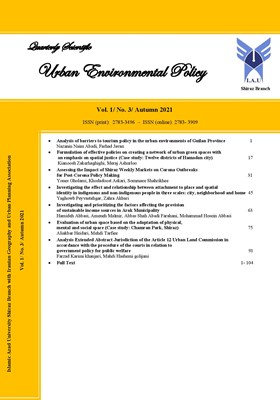-
-
List of Articles
-
Open Access Article
1 - Analysis of barriers to tourism policy in the urban environments of Guilan Province
Nazanin Naim Abadi Farhad Javan -
Open Access Article
2 - Formulation of effective policies on creating a network of urban green spaces with an emphasis on spatial justice (Case study: Twelve districts of Hamadan city)
Kianoosh Zakerhaghighi Meraj Ashurloo -
Open Access Article
3 - Assessing the Impact of Shiraz Weekly Markets on Corona Outbreaks for Post-Corona Policy Making
yones gholami khodadoust askari somaee shahrokhi -
Open Access Article
4 - Investigating the effect and relationship between attachment to place and spatial identity in indigenous and non-indigenous people in three scales: city, neighborhood and home
yaghowb peyvastehgar zahra akbari -
Open Access Article
5 - Investigating and prioritizing the factors affecting the provision of sustainable income sources in Arak Municipality
hamideh abbasi ameneh malmir abbas shahabadi farahani mohammad hosein abbasi -
Open Access Article
6 - Evaluation of urban space based on the adaptation of physical, mental and social space (Case study: Chamran Park, Shiraz)
ali akbar heidari mehdi Tarfiee -
Open Access Article
7 - Analysis Jurisdiction of the Article 12 Urban Land Commission in accordance with the procedure of the courts in relation to government policy for public welfare
Farzad Karimi khanjari mahdi hashemi golijani
-
The rights to this website are owned by the Raimag Press Management System.
Copyright © 2021-2025







